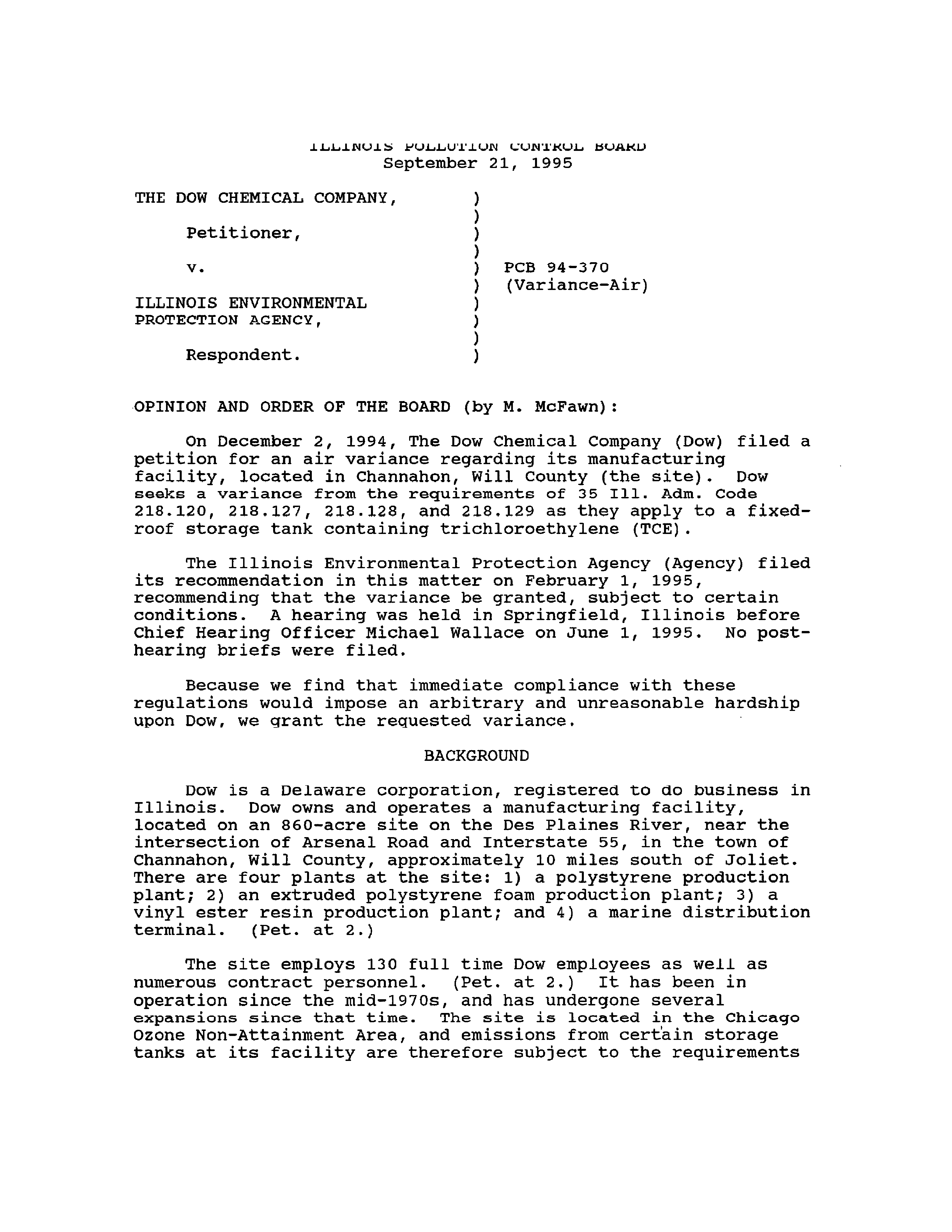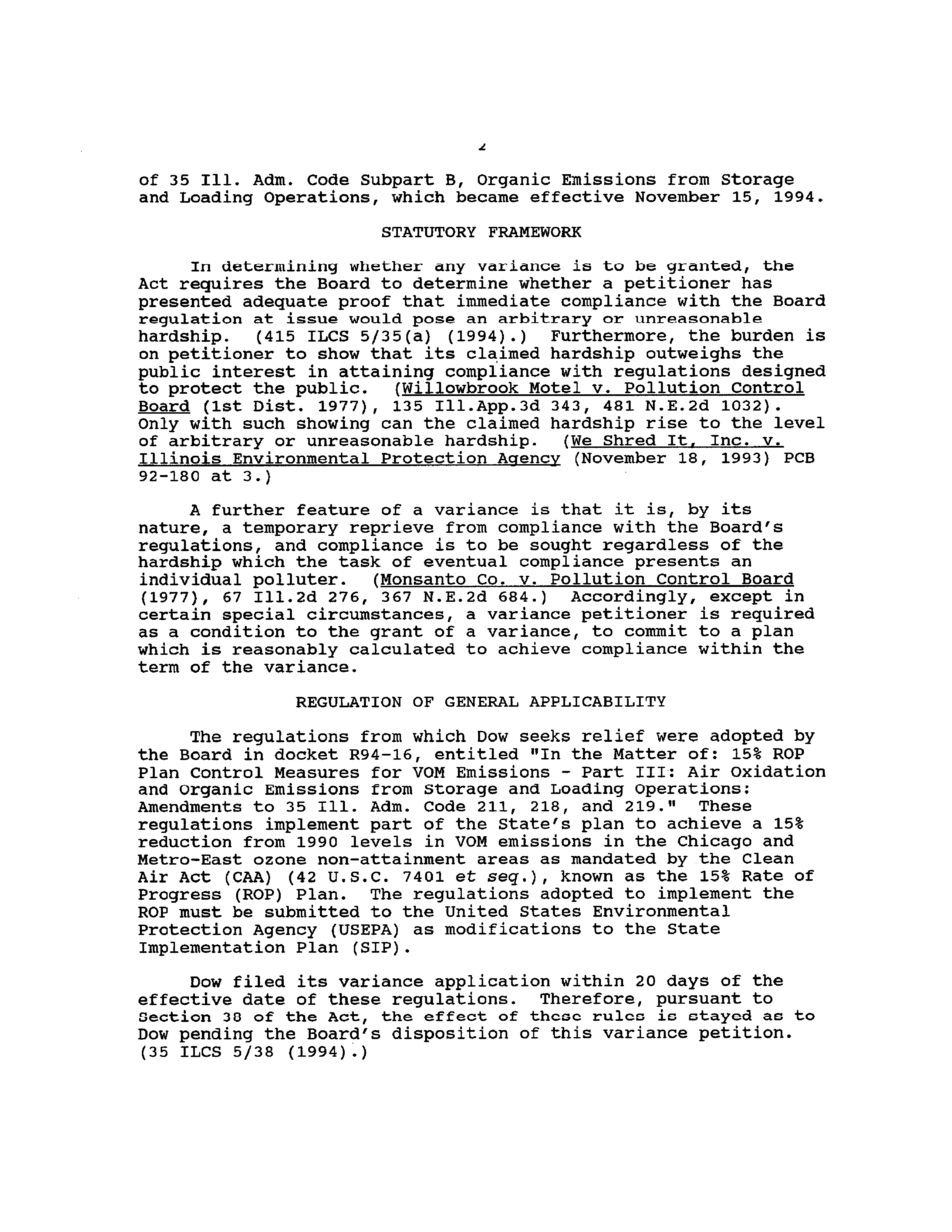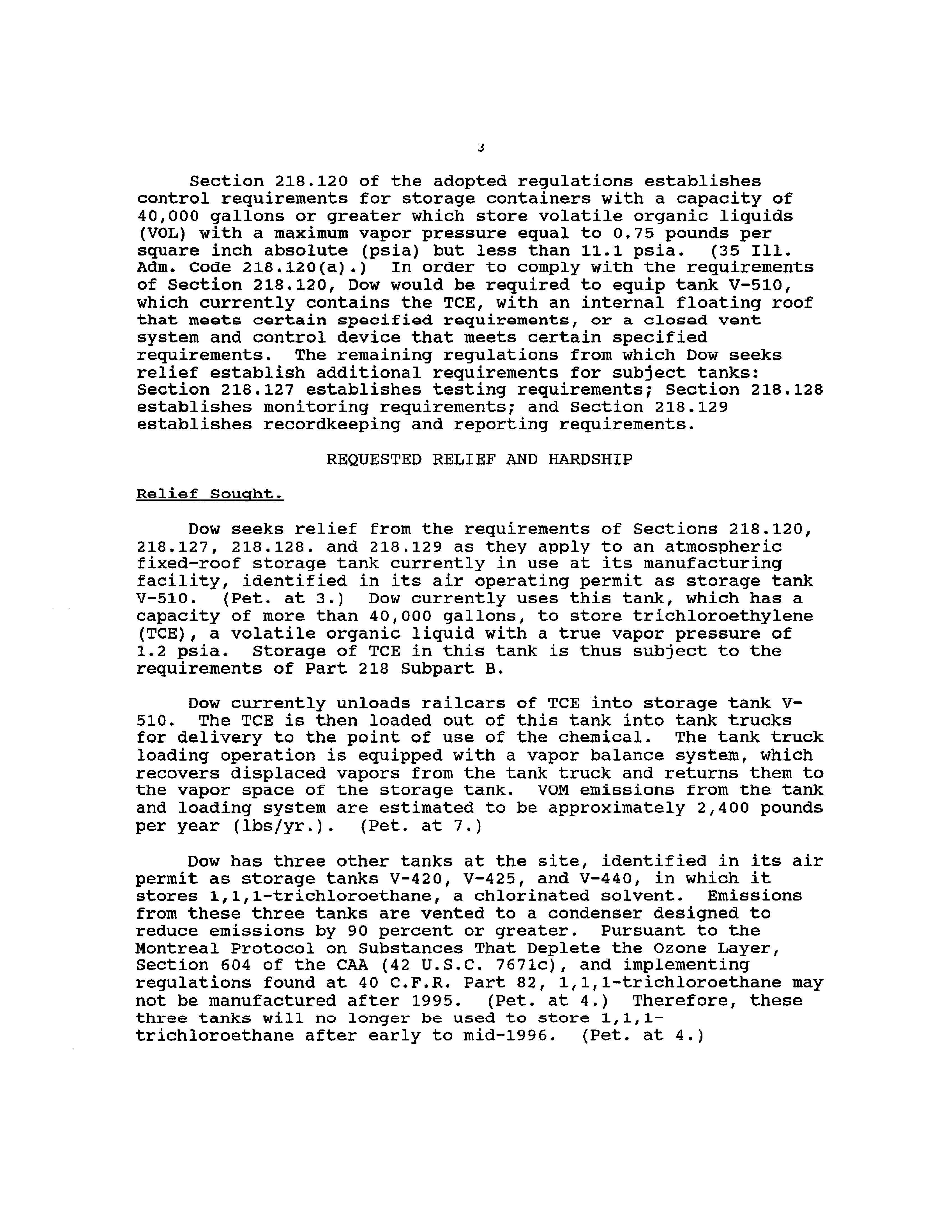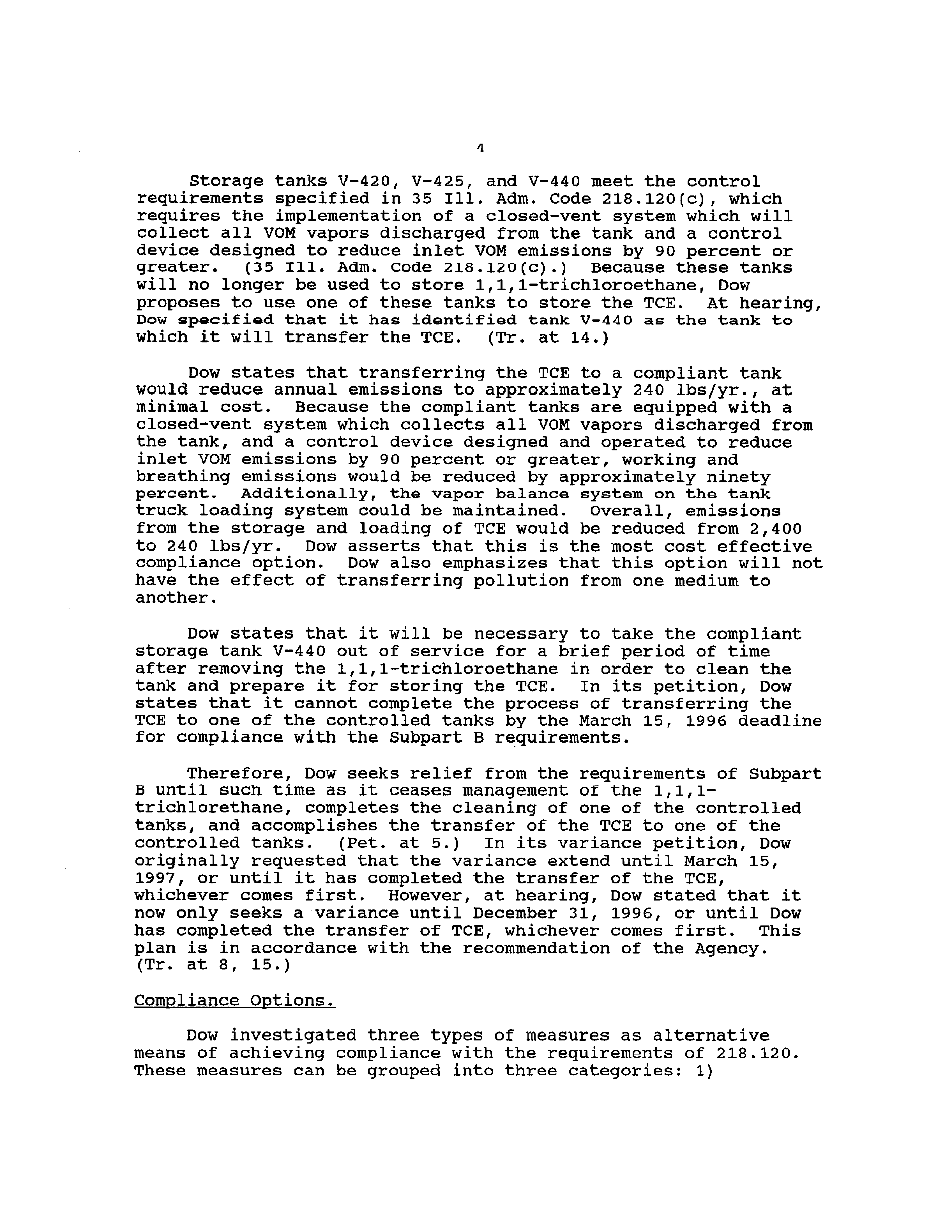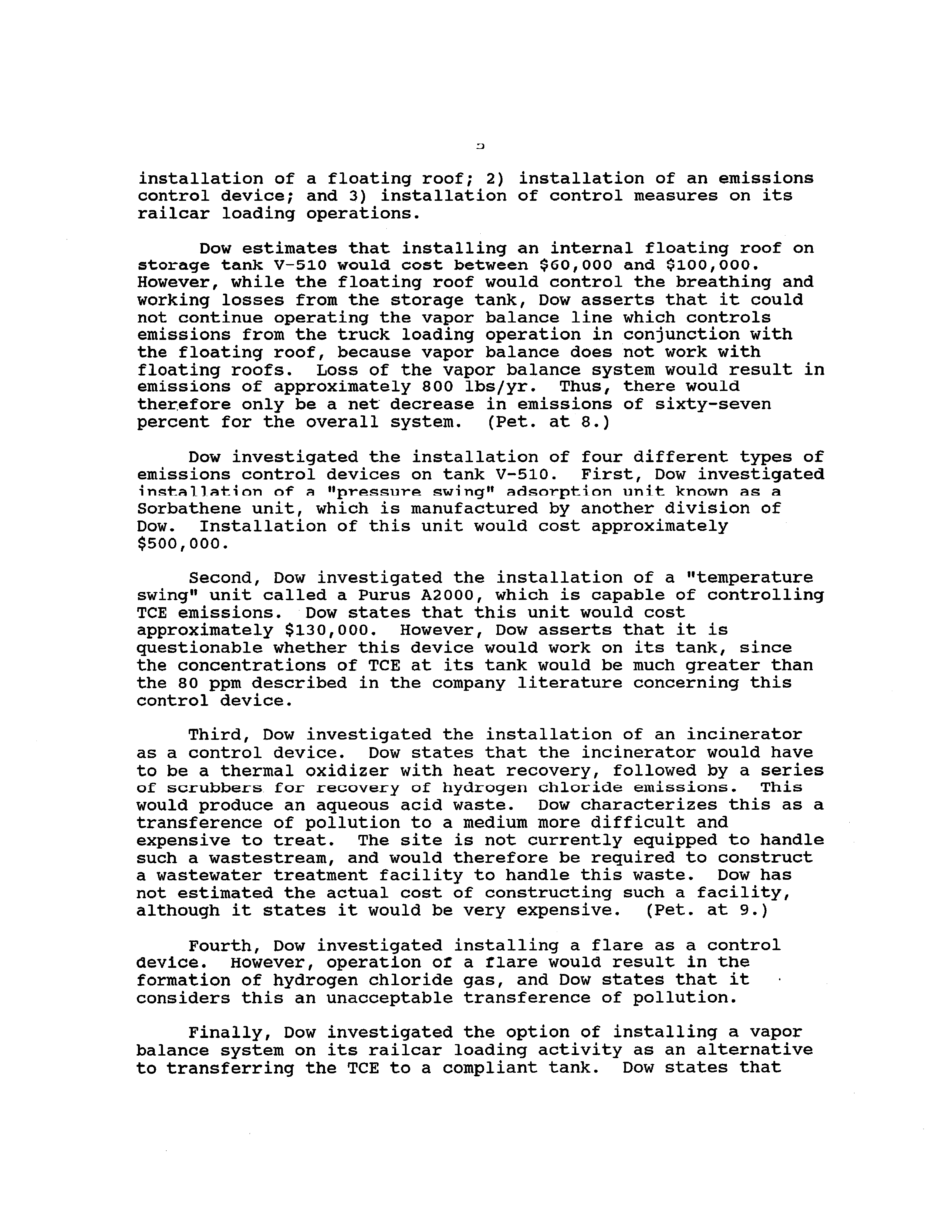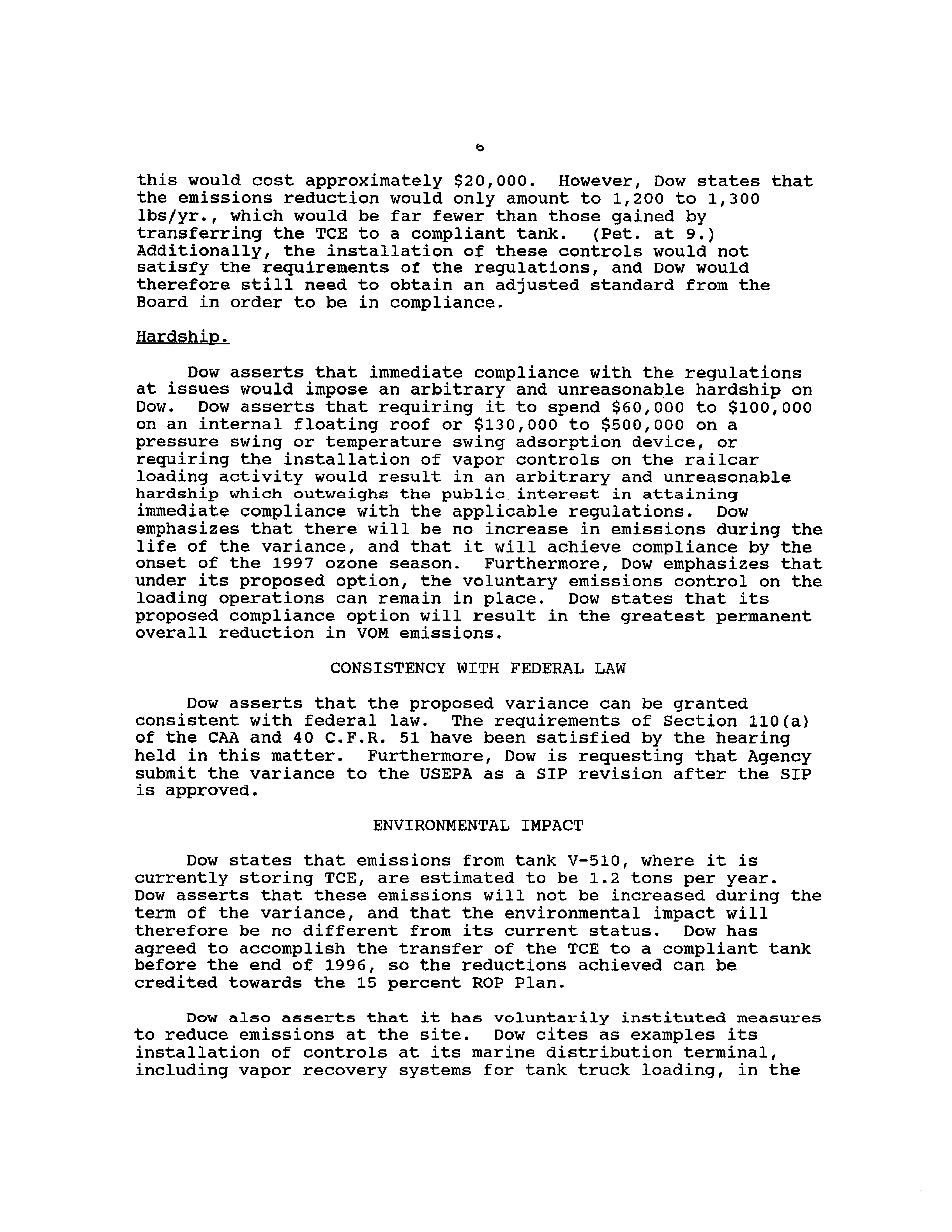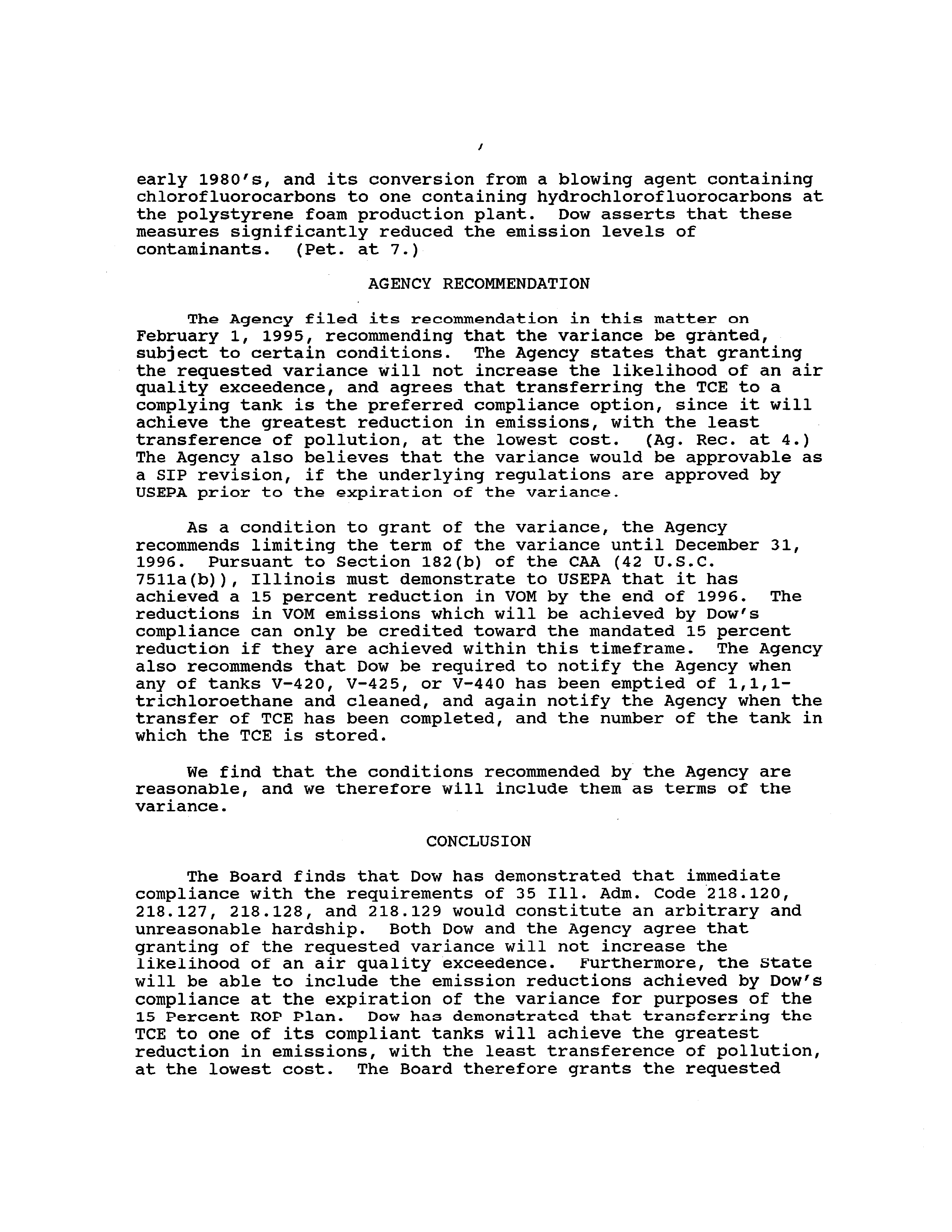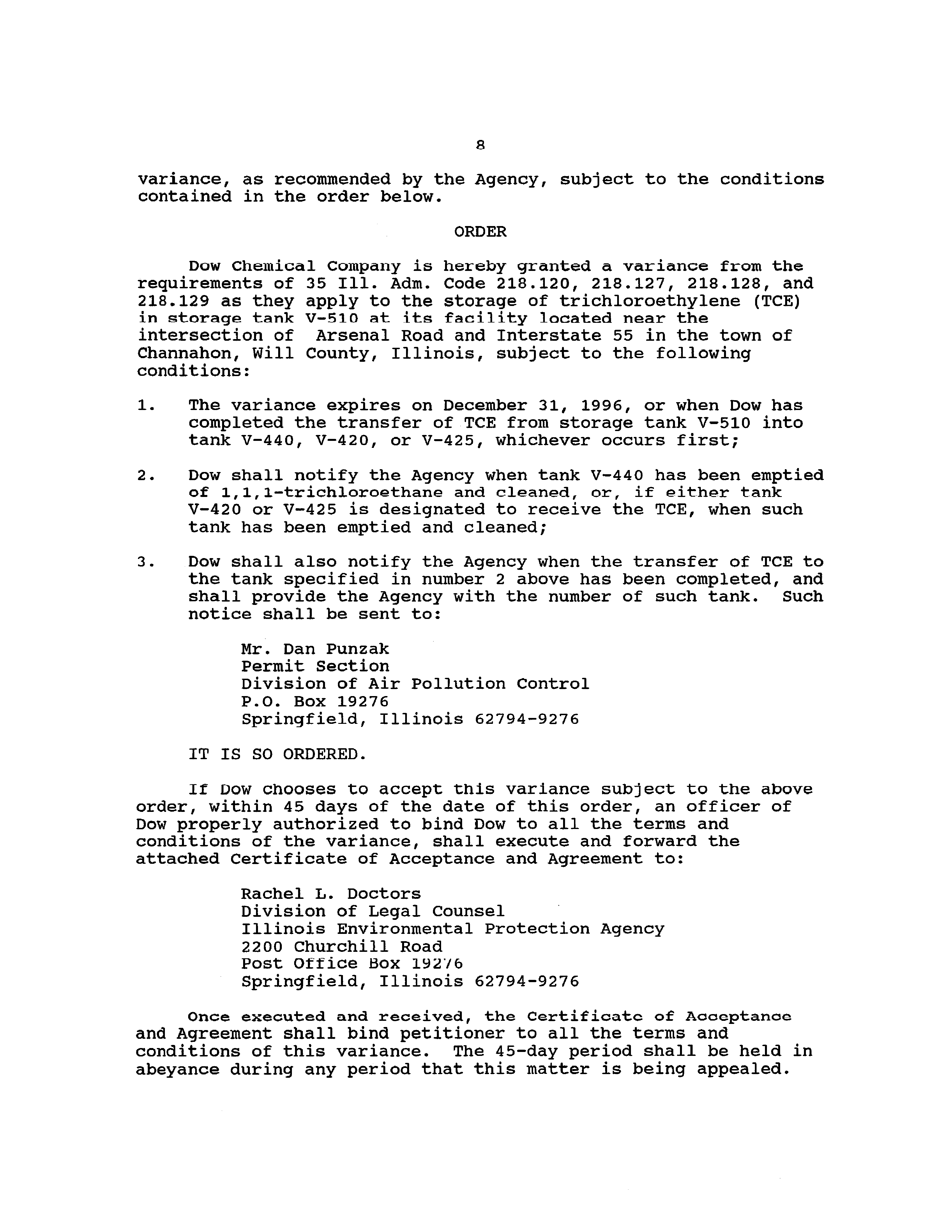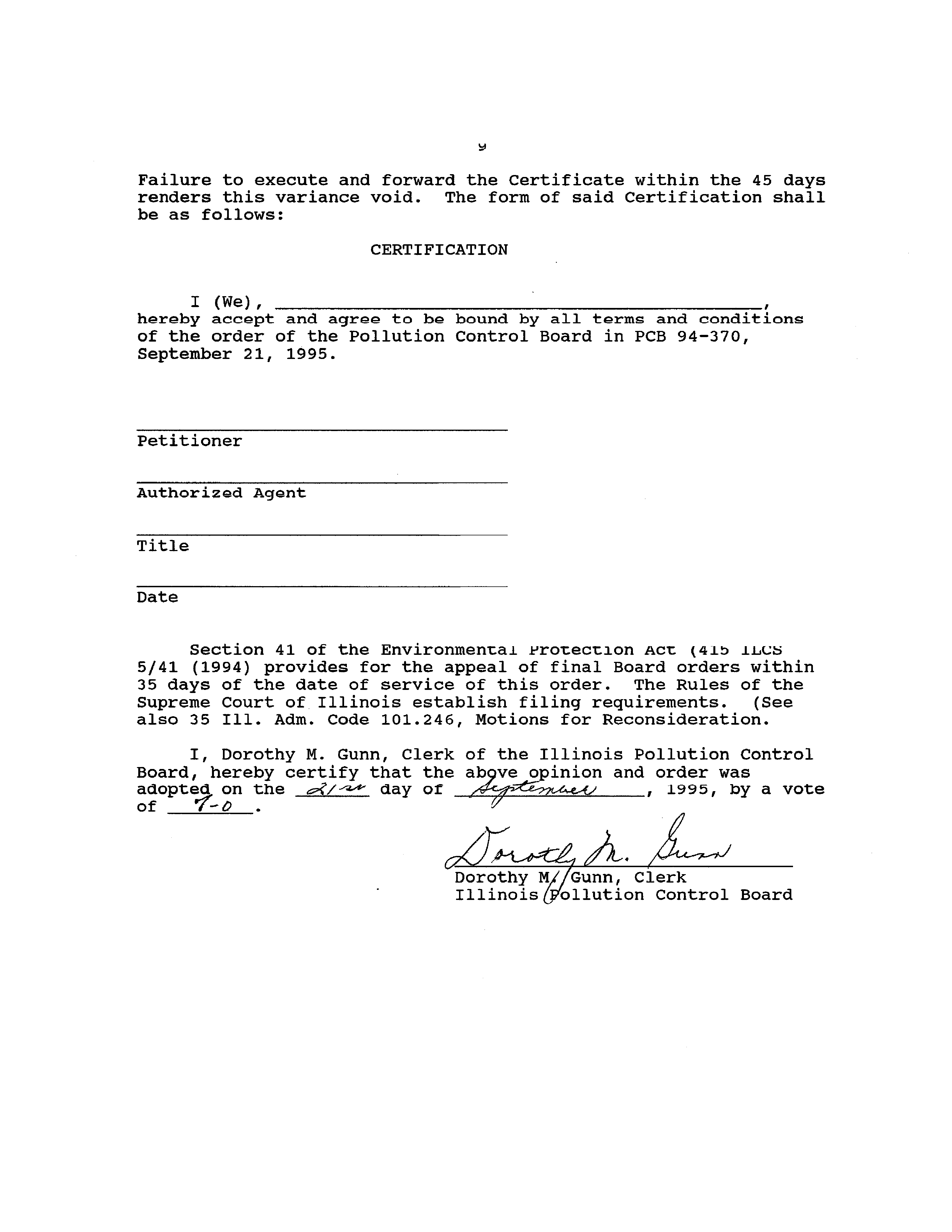SLLaSNUSS
£~L)LjLJUTSUN
LUDEXKUL~
bOARL)
September 21,
1995
THE DOW CHEMICAL COMPANY,
)
Petitioner,
v.
)
PCB 94—370
)
(Variance—Air)
ILLINOIS ENVIRONMENTAL
PROTECTION AGENCY,
)
Respondent.
OPINION
AND
ORDER OF THE BOARD (by N. McFawn):
On December 2,
1994,
The Dow Chemical Company
(Dow)
filed a
petition for an air variance regarding its manufacturing
facility, located in Channahon, Will County
(the site).
Dow
seeks a variance from the requirements of
35 Ill. Adn. Code
218.120, 218.127, 218.128, and 218.129 as they apply to a fixed—
roof storage tank containing trichloroethylene
(TCE).
The Illinois Environmental Protection Agency (Agency)
filed
its recommendation
in this matter on February
1,
1995,
recommending that the variance be granted,
subject to certain
conditions.
A hearing was held in Springfield, Illinois before
Chief Hearing Officer Michael Wallace on June
1,
1995.
No post-
hearing briefs were filed.
Because we find that immediate compliance with these
regulations would impose an arbitrary and unreasonable hardship
upon Dow, we grant the requested variance.
BACKGROUND
Dow is a Delaware corporation, registered to do business in
Illinois.
Dow owns and operates a manufacturing facility,
located on an 860—acre site on the Des Plaines River, near the
intersection of Arsenal Road and Interstate 55,
in the town of
Channahon, Will County, approximately 10 miles south of Joliet.
There are four plants at the site:
1) a polystyrene production
plant;
2) an extruded polystyrene foam production plant;
3)
a
vinyl ester resin production plant; and
4) a marine distribution
terminal.
(Pet.
at
2.)
The site employs 130 full time Dow employees as well as
numerous contract personnel.
(Pet. at
2.)
It has been in
operation since the mid-1970s, and has undergone several
expansions
since that tine.
The site is located in the Chicago
Ozone Non-Attainment Area,
and emissions from cert~instorage
tanks at its facility are therefore subject to the requirements
I
of 35 Ill. Adm. Code Subpart B, Organic Emissions from Storage
and Loading Operations, which became effective November 15,
1994.
STATUTORY
FRAMEWORK
In
determining
whether
any
variance
is
to
be
granted,
the
Act
requires
the
Board
to
determine
whether
a
petitioner
has
presented
adequate
proof
that
immediate
compliance
with
the
Board
regulation
at
issue
would
pose
an
arbitrary
or
unreasonable
hardship.
(415
ILCS
5/35(a)
(1994).)
Furthermore,
the
burden
is
on
petitioner
to
show
that
its
claimed
hardship
outweighs
the
public
interest
in
attaining
compliance
with
regulations
designed
to
protect
the
public.
(Willowbrook
Motel
v.
Pollution
Control
Board
(1st
Dist.
1977),
135 Ill.App.3d 343,
481
N.E.2d
1032).
Only with such showing can the claimed hardship rise to the level
of arbitrary or unreasonable hardship.
(We Shred It.
Inc.
v.
Illinois Environmental Protection Agency (November 18,
1993)
PCB
92—180 at 3.)
A further feature of a variance is that it
is, by its
nature,
a temporary reprieve from compliance with the Board’s
regulations, and compliance is to be sought regardless of the
hardship which the task of eventual compliance presents an
individual polluter.
(Monsanto Co. v. Pollution Control Board
(1977),
67 Ill.2d 276,
367 N.E.2d 684.)
Accordingly,
except in
certain special circumstances,
a variance petitioner is required
as a condition to the grant of a variance, to commit to a plan
which is reasonably calculated to achieve compliance within the
term of the variance.
REGULATION OF GENERAL APPLICABILITY
The regulations from which Dow seeks relief were adopted by
the Board in docket R94-16, entitled “In the Matter of:
15
ROP
Plan Control Measures for VON Emissions
-
Part III: Air Oxidation
and organic Emissions from Storage and Loading operations;
Amendments to 35 Ill.
Adm. Code 211,
218, and 219.”
These
regulations implement part of the State’s plan to achieve a 15
reduction from 1990 levels in VON emissions in the Chicago and
Metro—East ozone non—attainment areas as mandated by the Clean
Air Act
(CAA)
(42 U.S.C. 7401 et
seq.),
known as the 15
Rate of
Progress
(ROP)
Plan.
The regulations adopted to implement the
ROP must be submitted to the United States Environmental
Protection Agency
(USEPA)
as modifications to the State
Implementation Plan
(SIP).
Dow filed its variance application within 20 days of the
effective date of these regulations.
Therefore, pursuant to
Section
38 of the Act, the effect
of
thcoc rules
is
stayed as to
Dow pending the Board’s disposition of this variance petition.
(35 ILCS 5/38
(1994).)
Section
218.120
of
the
adopted
regulations
establishes
control requirements for storage containers with a capacity of
40,000 gallons or greater which store volatile organic liquids
(VOL) with a maximum vapor pressure equal to 0.75 pounds per
square inch absolute
(psia) but less than 11.1 psia.
(35 Ill.
Adm. Code 218.120(a).)
In order to comply with the requirements
of Section 218.120, Dow would be required to equip tank V-Sb,
which currently contains the TCE, with an internal floating roof
that meets certain specified requirements, or a closed vent
system and control device that meets certain specified
requirements.
The remaining regulations from which Dow seeks
relief establish additional requirements for subject tanks:
Section 218.127 establishes testing requirements; Section 218.128
establishes monitoring requirements; and Section 218.129
establishes recordkeeping and reporting requirements.
REQUESTED RELIEF AND HARDSHIP
Relief
Sought.
Dow seeks relief from the requirements of Sections 218.120,
218.127,
218.128. and 218.129 as they apply to an atmospheric
fixed—roof storage tank currently in use at its manufacturing
facility, identified in its air operating permit as storage tank
V-5l0.
(Pet.
at
3.)
Dow currently uses this tank, which has a
capacity of more than 40,000 gallons,
to store trichloroethylene
(TCE),
a volatile organic liquid with a true vapor pressure of
1.2 psia.
Storage of TCE in this tank is thus subject to the
requirements of Part 218 Subpart
B.
Dow currently unloads railcars of TCE into storage tank V—
510.
The TCE is then loaded out of this tank into tank trucks
for delivery to the point of use of the chemical.
The tank truck
loading operation is equipped with a vapor balance system, which
recovers displaced vapors from the tank truck and returns them to
the vapor space of the storage tank.
VON emissions from the tank
and
loading
system
are
estimated
to
be
approximately
2,400
pounds
per
year
(lbs/yr.).
(Pet.
at 7.)
Dow has three other tanks at the site,
identified in its air
permit as storage tanks V-420, V-425,
and V-440,
in which it
stores 1,1,1—trichloroethane, a chlorinated solvent.
Emissions
from these three tanks are vented to
a condenser designed to
reduce emissions by 90 percent or greater.
Pursuant to the
Montreal Protocol on Substances That Deplete the Ozone Layer,
Section 604 of the
CAA
(42 U.S.C. 7671c),
and implementing
regulations found at 40 C.F.R. Part 82, 1,1,1-trichloroethane may
not be manufactured after 1995.
(Pet.
at
4.)
Therefore,
these
three tanks will no longer be used to store 1,1,1—
trichioroethane after early to mid-1996.
(Pet.
at
4.)
‘I
Storage
tanks
V-420,
V-425,
and
V-440
meet
the control
requirements specified in 35
Ill. Adm. Code 218.120(c), which
requires the implementation of
a closed—vent system which will
collect all VON vapors discharged from the tank and a control
device designed to reduce inlet VON emissions by 90 percent or
greater.
(35 Ill. Adm. code 218.120(c).)
Because these tanks
will no longer be used to store b,b,b—trichloroethane, Dow
proposes to use one of these tanks to store the TCE.
At hearing,
Dow
specified
that
it has identified tank V-440
as
the tank to
which it will transfer the TCE.
(Tr.
at
14.)
Dow states that transferring the TCE to a compliant tank
would reduce annual emissions to approximately 240 lbs/yr., at
minimal cost.
Because the compliant tanks are equipped with a
closed—vent system which collects all VON vapors discharged from
the tank, and a control device designed and operated to reduce
inlet VON emissions by 90 percent or greater, working and
breathing emissions would be reduced by approximately ninety
percent.
Additionally, the vapor balance system on the tank
truck loading system could be maintained.
overall, emissions
from the storage and loading of TCE would be reduced from 2,400
to 240 lbs/yr.
Dow asserts that this
is the most cost effective
compliance option.
Dow also emphasizes that this option will not
have the effect of transferring pollution from one medium to
another.
Dow states that it will be necessary to take the compliant
storage tank V-440 out of service for a brief period of time
after removing the l,l,l-trichloroethane in order to clean the
tank and prepare it for storing the TCE.
In its petition, Dow
states that it cannot complete the process of transferring the
TCE to one of the controlled tanks by the March 15,
1996 deadline
for compliance with the Subpart B requirements.
Therefore,
Dow seeks relief from the requirements of Subpart
B until such time as it ceases management of the 1,1,1—
trichlorethane,
completes the cleaning of one of the controlled
tanks, and accomplishes the transfer of the TCE to one of the
controlled tanks.
(Pet.
at 5.)
In its variance petition,
Dow
originally requested that the variance extend until March 15,
1997,
or until it has completed the transfer of the TCE,
whichever comes first.
However,
at hearing, Dow stated that it
now only seeks a variance until December 31,
1996, or until Dow
has completed the transfer of TCE, whichever comes first.
This
plan is in accordance with the recommendation of the Agency.
(Tr. at
8,
15.)
Compliance Options.
Dow investigated three types of measures as alternative
means of achieving compliance with the requirements of 218.120.
These measures can be grouped into three categories:
1)
installation of a floating roof;
2)
installation of an emissions
control device; and
3) installation of control
measures
on
its
railcar loading operations.
Dow estimates that installing an internal floating roof on
storage tank V-510 would cost between $60,000 and
$100,000.
However, while the floating roof would control the breathing and
working
losses
from
the
storage
tank,
Dow
asserts
that
it
could
not continue operating the vapor balance line which controls
emissions from the truck loading operation in conjunction with
the floating roof,
because vapor balance does not work with
floating
roofs.
Loss
of
the
vapor
balance
system would result in
emissions of approximately 800 lbs/yr.
Thus,
there would
therefore only be a net decrease in emissions of sixty—seven
percent for the overall system.
(Pet.
at 8.)
Dow investigated the installation of four different types of
emissions control devices on tank V—510.
First, Dow investigated
in~tai.iatioi,
of
~ “pressure swing” adsorption
unit known
as a
Sorbathene unit,
which is manufactured by another division of
Dow.
Installation of this unit would cost approximately
$500,000.
Second, Dow investigated the installation of a “temperature
swing”
unit
called
a
Purus
A2000,
which is capable of controlling
TCE emissions.
Dow states that this unit would cost
approximately $130,000.
However, Dow asserts that it is
questionable
whether
this
device
would
work on its tank,
since
the concentrations of TCE at its tank would be much greater than
the 80 ppm described in the company literature concerning this
control device.
Third,
Dow
investigated the installation of an incinerator
as a control device.
Dow states that the incinerator would have
to be a thermal oxidizer with heat recovery, followed by a series
of
scrubbers for recovery of hydrogen chloride emissions.
This
would produce an aqueous acid waste.
Dow characterizes this as a
transference
of pollution to a medium more difficult and
expensive
to
treat.
The
site
is
not
currently
equipped
to
handle
such a wastestream,
and would therefore be required to construct
a wastewater treatment facility to handle this waste.
Dow has
not
estimated
the
actual
cost
of
constructing
such
a
facility,
although
it
states
it would be very expensive.
(Pet. at 9.)
Fourth,
Dow investigated installing a flare as a control
device.
However, operation of a flare would result in the
formation of hydrogen chloride gas, and Dow states that it
considers this an unacceptable transference of pollution.
Finally, Dow investigated the option of installing a vapor
balance
system
on
its railcar loading activity as an alternative
to transferring the TCE to a compliant tank.
Dow states that
b
this would
cost
approximately $20,000.
However, Dow states that
the emissions reduction would only amount to 1,200 to 1,300
lbs/yr., which would be far fewer than those gained by
transferring the TCE to a compliant tank.
(Pet.
at
9.)
Additionally, the installation of these controls would not
satisfy the requirements of the regulations, and Dow would
therefore
still
need
to
obtain
an
adjusted standard from the
Board in order to be in compliance.
Hardship.
Dow asserts that immediate compliance with the regulations
at issues would impose an arbitrary and unreasonable hardship on
Dow.
Dow asserts that requiring it to spend $60,000 to $100,000
on an internal floating roof or $130,000 to $500,000 on a
pressure swing or temperature swing adsorption device, or
requiring the installation of vapor controls on the railcar
loading activity would result in an arbitrary and unreasonable
hardship which outweighs the publicS interest in attaining
immediate compliance with the applicable regulations.
Dow
emphasizes that there will be no increase in emissions during the
life of the variance, and that it will achieve compliance by the
onset of the 1997 ozone season.
Furthermore, Dow emphasizes that
under its proposed option, the voluntary emissions control on the
loading operations can remain in place.
Dow states that its
proposed compliance option will result in the greatest permanent
overall reduction in VON emissions.
CONSISTENCY WITH FEDERAL LAW
Dow asserts that the proposed variance can be granted
consistent with federal
law.
The requirements of Section 110(a)
of the
CAA
and 40 C.F.R.
51 have been satisfied by the hearing
held in this matter.
Furthermore, Dow is requesting that Agency
submit the variance to the USEPA as a SIP revision after the SIP
is approved.
ENVIRONMENTAL IMPACT
Dow states that emissions from tank V—510, where it is
currently storing TCE,
are estimated to be 1.2 tons per year.
Dow asserts that these emissions will not be increased during the
term of the variance, and that the environmental impact will
therefore be no different from its current status.
Dow has
agreed to accomplish the transfer of the TCE to a compliant
tank
before the end of 1996, so the reductions achieved can be
credited towards the 15 percent
flOP Plan.
Dow also asserts that it has voluntarily
instituted
measures
to reduce emissions at the site.
Dow cites as examples its
installation of controls at its marine distribution terminal,
including
vapor
recovery
systems
f
or tank truck loading,
in the
early 1980’s, and its conversion from a blowing agent containing
chiorofluorocarbons to one containing hydrochlorofluorocarbons at
the polystyrene foam production plant.
Dow asserts that these
measures significantly reduced the emission levels of
contaminants.
(Pet.
at
7.)
AGENCY RECOMMENDATION
The Agency filed its
recommendation
in this matter on
February 1,
1995, recommending that the variance be granted,
subject to certain conditions.
The Agency states that granting
the requested variance will not increase the likelihood of an air
quality exceedence, and agrees that transferring the TCE to a
complying tank is the preferred compliance option, since it will
achieve the greatest reduction in emissions, with the least
transference
of
pollution,
at
the
lowest
cost.
(Ag.
Rec.
at
4.)
The
Agency
also
believes that the variance would be approvable as
a SIP revision,
if the underlying regulations are approved by
USEPA prior to the expiration of the variance.
As a condition to grant of the variance, the Agency
recommends limiting the term of the variance until December 31,
1996.
Pursuant to Section 182(b)
of the
CAA
(42 U.S.C.
7511a(b)),
Illinois must demonstrate to USEPA that it has
achieved a 15 percent reduction in VOM by the end of 1996.
The
reductions in VOM emissions which will be achieved by Dow’s
compliance can only be credited toward the mandated 15 percent
reduction if they are achieved within this timeframe.
The Agency
also recommends that Dow be required to notify the Agency when
any of tanks V—420, V-425,
or V-440 has been emptied of 1,1,1-
trichioroethane and cleaned, and again notify the Agency when the
transfer of TCE has been completed, and the number of the tank in
which the TCE is stored.
we find that the conditions recommended by the Agency are
reasonable, and we therefore will include them as terms of the
variance.
CONCLUSION
The Board finds that Dow has demonstrated that immediate
compliance with the requirements of 35 Ill. Adm. Code 218.120,
218.127,
218.128,
and
218.129
would
constitute
an
arbitrary
and
unreasonable hardship.
Both Dow and the Agency agree that
granting of the requested variance will not increase the
likelihood
of an air quality éxceedence.
Furthermore, the State
will be able to include the emission reductions achieved by Dow’s
compliance at the expiration of the variance for purposes of the
15 Percent
flOP Plan.
Dow ha~ dcmonotratcd that tranoferring
the
TCE
to one of
its
compliant
tanks
will achieve the greatest
reduction in emissions,
with the least transference of pollution,
at the lowest cost.
The Board therefore
grants
the requested
B
variance, as recommended by the Agency, subject to the conditions
contained in the order below.
ORDER
Dow Chemical Company is hereby granted a variance from the
requirements of 35 Ill. Adm. Code 218.120, 218.127, 218.128, and
218.129 as they apply to the storage of trichloroethylene
(TCE)
in storage
tank V-510
at
its
facdlity
located near the
intersection of
Arsenal Road and Interstate 55 in the
town
of
Channahon,
Will County,
Illinois, subject to the following
conditions:
1.
The variance expires on December 31,
1996,
or when Dow has
completed the transfer of TCE from storage tank V-510 into
tank V-440, V—420,
or V—425, whichever occurs first;
2.
Dow shall notify the Agency when tank V-440 has been emptied
of 1,1,1—trichioroethane
and cleaned,
or,
if either tank
V—420 or V—425
is designated to receive the TCE, when such
tank has been emptied and
cleaned;
3.
Dow shall also notify the Agency when the transfer of TCE to
the tank specified
in number
2 above has been completed,
and
shall provide the Agency with the number of such tank.
Such
notice shall be sent to:
Mr. Dan Punzak
Permit Section
Division of Air Pollution Control
P.O. Box 19276
Springfield,
Illinois 62794—9276
IT IS SO ORDERED.
If vow chooses to accept this variance subject to the above
order, within 45 days of the date of this order,
an officer of
Dow properly authorized to bind Dow to all the terms and
conditions of the variance, shall execute and forward the
attached Certificate
of Acceptance and Agreement
to:
Rachel L. Doctors
Division of Legal Counsel
Illinois Environmental Protection Agency
2200 Churchill Road
Post Office Box
192’/6
Springfield, Illinois 62794—9276
Once executed and received,
the Certificate of Acceptance
and Agreement shall
bind petitioner to all the terms and
conditions
of
this variance.
The 45-day period shall be held in
abeyance during any period that this matter is being appealed.
Failure to execute and forward the Certificate within the 45 days
renders this variance void.
The form of said Certification shall
be as follows:
CERTIFICATION
I
(We),
hereby accept and agree
to
be bound by all
terms and conditions
of the order of the Pollution Control Board in PCB 94-370,
September 21,
1995.
Petitioner
Authori2ed Agent
Title
Date
Section 41 of the Environmentai ±~rotection
ACt
(41b
IIJUS
5/41
(1994) provides for the appeal of final Board orders within
35 days of the date of service of this order.
The Rules of the
Supreme Court of Illinois establish filing requirements.
(See
also 35 Ill. Adm. Code 101.246, Motions for Reconsideration.
I, Dorothy M. Gunn,
Clerk of the Illinois Pollution Control
Board, hereby certify that the ab ye opinion and order was
adopted on the
~/-~
d.ay or
-
,
1995,
by a vote
of
_____.
Dorothy N//Gunn, Clerk
Illinois(~ollutionControl Board
